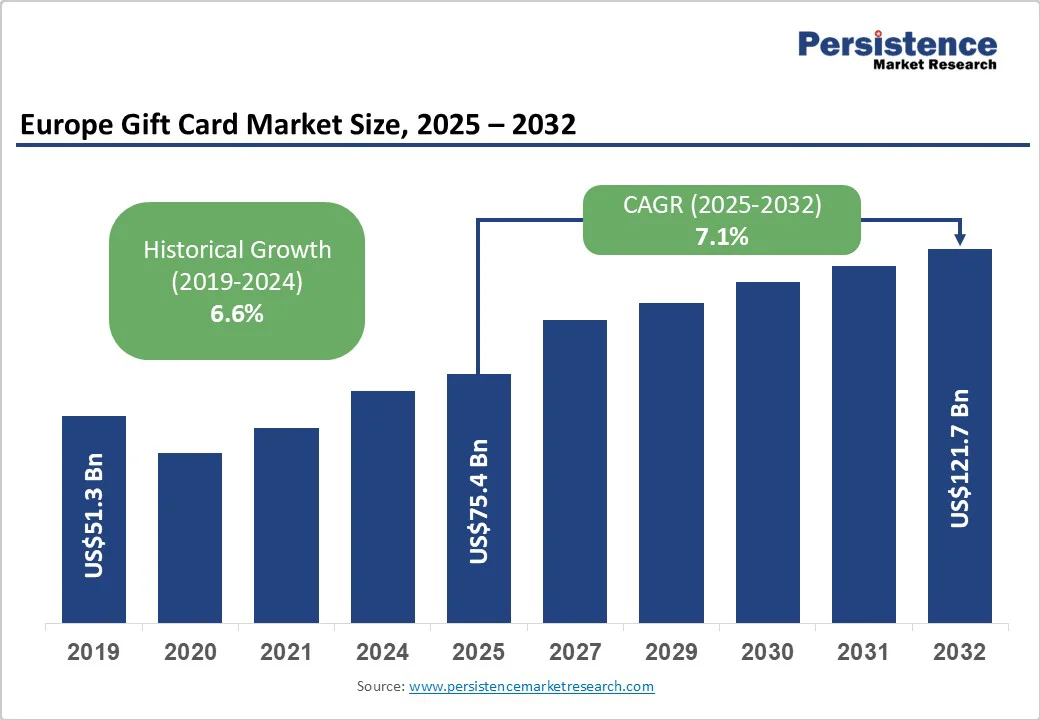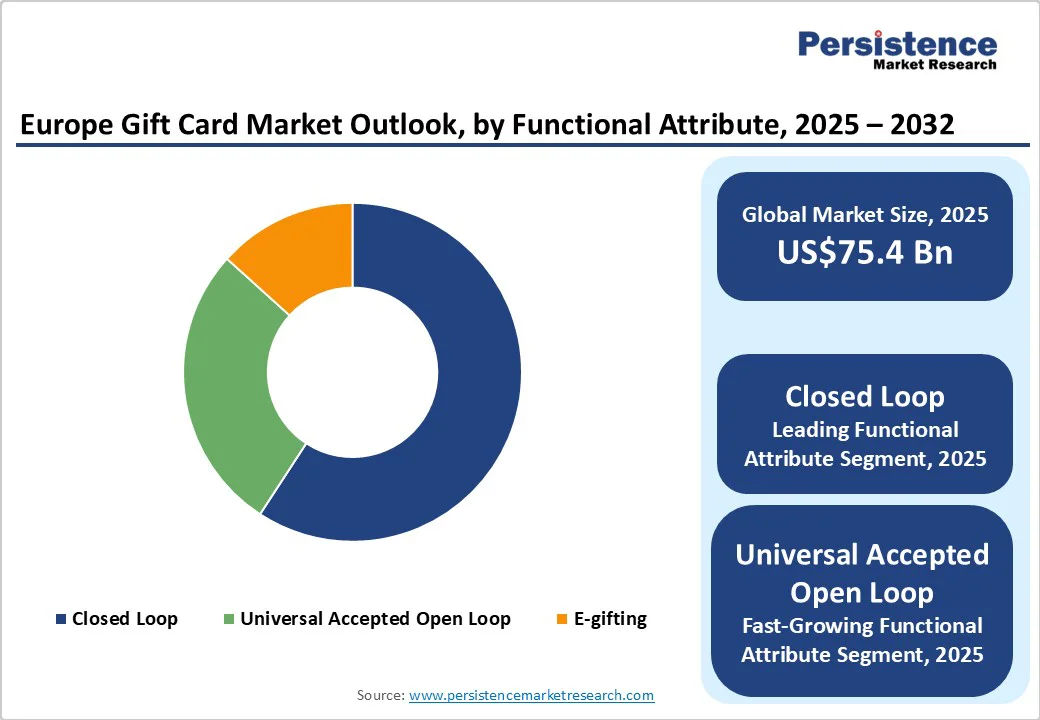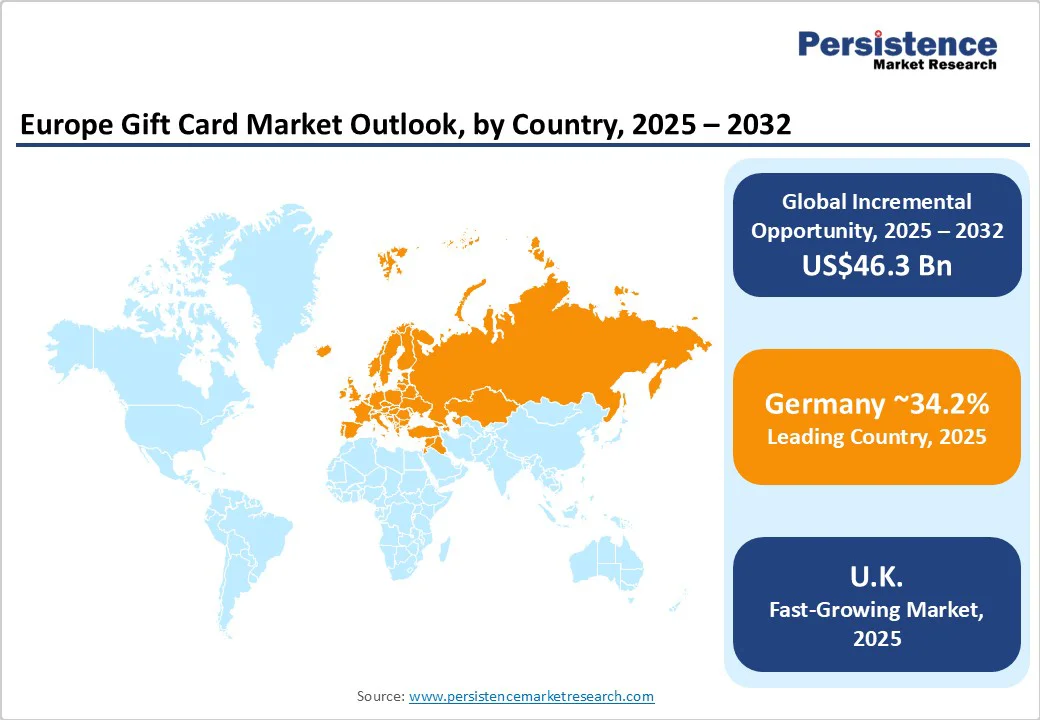ID: PMRREP33121| 174 Pages | 9 Oct 2025 | Format: PDF, Excel, PPT* | Consumer Goods

The Europe gift card market size is likely to be valued at US$75.4 Billion in 2025 and is estimated to reach US$121.7 Billion in 2032, growing at a CAGR of 7.1% during the forecast period 2025-2032, driven by convenience, personalization, and digital adoption. Digital e-gift cards are particularly popular due to instant delivery, easy redemption, and integration with mobile wallets.
| Key Insights | Details |
|---|---|
|
Europe Gift Card Market Size (2025E) |
US$75.4 Billion |
|
Market Value Forecast (2032F) |
US$121.7 Billion |
|
Projected Growth (CAGR 2025 to 2032) |
7.1% |
|
Historical Market Growth (CAGR 2019 to 2024) |
6.6% |

One of the main reasons gift cards are gaining popularity in Europe is that they empower recipients to select products or experiences they genuinely want. Unlike traditional gifts, which may miss the mark or go unused, gift cards provide flexibility and reduce the risk of dissatisfaction.
It makes them appealing for occasions such as birthdays, weddings, or corporate rewards, where ensuring the recipient feels valued is essential. Retailers benefit as well, since recipients often spend beyond the card’s value when redeeming it, boosting sales. For example, Starbucks’ gift cards in Europe allow users to reload balances, choose beverages or merchandise, and integrate purchases with loyalty programs.
The ongoing adoption of digital gift cards is augmented by convenience and speed. They can be purchased online in minutes, delivered instantly via email or messaging apps, and redeemed at both online and physical stores. This is important for last-minute gifts, seasonal shopping, or corporate incentives where quick distribution is important.
Platforms such as Klarna’s Gift Card Store and Amazon’s e-gift cards provide scheduling options, instant delivery, and mobile wallet integration, improving the gifting process. The ease of digital redemption and compatibility with contactless payments further refines the user experience, making digital gift cards a preferred choice for tech-savvy consumers and busy professionals.
Gift card usage is often restricted by Know Your Customer (KYC) and Anti-Money Laundering (AML) regulations, which impose limits on card values and require identity verification for large transactions. These constraints can hamper adoption, especially for high-value corporate incentives or international transfers, as additional paperwork or verification steps are required.
For instance, various prepaid open-loop cards in Europe require registration before balances exceeding a certain threshold can be loaded or spent. This regulatory friction may discourage both individual consumers and businesses from using gift cards for bulk gifting, corporate rewards, or cross-border payments. The need to comply with these rules adds operational complexity for issuers such as Blackhawk Network or Edenred.
The upcoming rollout of the Digital Euro and initiatives such as the Wero digital payment scheme in Europe could pose a challenge to traditional gift card adoption. Central bank-backed digital currencies provide instant, secure, and programmable payments that could serve similar purposes as gift cards, mainly for peer-to-peer transfers, corporate rewards, or loyalty programs.
If these digital currencies are widely adopted, consumers and businesses may prefer them over prepaid cards for convenience, security, and low fees. For example, the European Central Bank’s pilot programs in 2025 are exploring cross-border payments and merchant integrations. This shows a potential substitution threat that gift card issuers need to address by emphasizing unique benefits such as brand loyalty, personalization, or multi-merchant flexibility.
One significant growth opportunity for gift cards lies in municipal or town multi-merchant programs. These cards allow recipients to spend across a network of local shops, restaurants, and service providers within a city, promoting regional commerce while delivering flexibility.
For example, Germany’s Stadtgutschein and the U.K.’s Town & City Gift Card programs have seen increasing adoption as municipalities encourage consumers to support local businesses. Such initiatives not only boost local economies but also create new distribution channels for gift card issuers. Retailers benefit from high footfall and repeat purchases, while consumers enjoy the convenience of a single card redeemable at multiple outlets.
Regulatory and technological developments in Europe, especially PSD3 and the EU Digital ID framework, provide another key growth avenue for gift cards. These standards enable instant top-ups, quick cross-border payments, and secure verification of users, thereby reducing friction in both purchase and redemption.
For instance, digital gift card platforms can now integrate EU Digital ID for smooth identity checks, allowing high-value cards to be issued instantly while remaining compliant with AML rules. Open-loop prepaid cards and corporate e-gift platforms, including Edenred and Blackhawk Network, are now using these capabilities to deliver near-instant digital delivery and wallet integration.
E-gift cards are anticipated to account for approximately 68.3% of the market share in 2025, as they provide instant delivery, easy personalization, and smooth digital integration. Consumers can send them within seconds through email or messaging apps, making them ideal for last-minute gifts. Platforms such as Klarna, PayPal, and Amazon allow buyers to customize e-gift cards with messages, designs, or videos, improving the gifting experience.
Physical gift cards continue to see steady growth due to their emotional and tangible appeal. Several consumers associate a physical card with greater thoughtfulness, making it a preferred choice for birthdays, weddings, and holidays. Retailers, including Tesco, Carrefour, and EDEKA, have expanded their in-store displays to include themed and multi-brand gift cards, which perform strongly during festive seasons. Physical cards also serve as impulse purchases at checkout counters, boosting sales.
Closed-loop cards are expected to hold a share of nearly 59.2% in 2025, owing to their ability to provide a superior sense of brand connection and targeted spending. Consumers often buy them for specific retailers or experiences, such as H&M, Amazon, or Zara, ensuring that the recipient gets something from a trusted or favorite brand. For retailers, these cards encourage repeat visits and high in-store spending. Studies show that recipients often spend more than the card’s value when redeeming them.
Universal accepted open-loop cards, including those backed by Visa, Mastercard, or American Express, are seeing constant growth because of their unmatched flexibility and cross-platform usability. They can be used anywhere these networks are accepted, which appeals to consumers looking for freedom of choice. Their popularity has surged with the rise of corporate and incentive gifting, where companies prefer open-loop cards for employee rewards to avoid brand limitations.
Corporate institutions are predicted to dominate with a share of about 78.3% of the market share in 2025, as gift cards provide flexibility, easy distribution, and personalization for employee rewards and client incentives. Digital or prepaid cards can be instantly sent to remote or hybrid employees, catering to the surging shift toward a digital workplace culture. Companies prefer them for tax-efficient bonuses and performance recognition programs, as various countries in Europe allow corporate gift cards under specific tax exemptions.
Retail is witnessing considerable growth in gift cards as they have become a key customer retention and sales tool. Renowned retailers such as Tesco, Carrefour, and MediaMarkt are using physical and digital gift cards not just for gifting but as promotional incentives, delivering bonus cards or cashback to propel store visits and repeat purchases. The rise of omnichannel shopping, where consumers move smoothly between online and physical stores, has also supported gift card adoption as they work across both formats.

In 2025, Germany is estimated to account for nearly 34.2% of the market share, owing to the popularity of instant online gifting and mobile-based redemption. Consumers now prefer digital gift cards that can be stored in apps or emailed directly, especially for entertainment, retail, and travel categories. Klarna recently expanded its Gift Card Store to Germany in partnership with Blackhawk Network, delivering flexible payment options such as Buy Now, Pay Later for brands, including H&M, LEGO, and NIKE. This entry highlights how fintech integration is transforming gift card accessibility and convenience in the country.
Large-scale distributors such as epay have also diversified their lines with multi-brand themed vouchers. For example, its Gutscheinfreude series includes gift cards dedicated to specific themes, including books or magazines, available at leading supermarket chains such as EDEKA. Similarly, Wunschgutschein (Wishcard Technologies) has become a household name, recognized by one in four consumers, by providing flexible cards redeemable at hundreds of retailers nationwide.
The field of gift cards in the U.K. has become increasingly digital, with online and mobile-based cards now surpassing physical ones in popularity. Consumers prefer e-gift cards as they can be sent instantly, used for online purchases, and stored easily in digital wallets. Retailers such as Amazon, Tesco, and Marks & Spencer have expanded their digital gift card options to cater to this demand. According to a new report, digital gift cards hold a majority of U.K. sales (52%) as of H1 2024.
Another key development is the rise of local and community gift cards. Programs such as Miconex’s Town & City Gift Card initiative allow consumers to buy multi-merchant cards that can be spent at local shops, helping small businesses compete with large retailers. This trend has grown rapidly, with sales increasing notably in 2024 as local councils promoted ‘shop local’ campaigns to strengthen regional economies.
France’s market is currently moving toward full digitalization, supported by new government regulations and consumer preferences. The country’s government has mandated that restaurant vouchers must become fully digital by 2026, signaling a broad shift toward paperless gifting. Retailers and service providers are responding quickly. For instance, Smartbox has introduced a fully digital B2B gift card platform that allows companies to manage corporate gifting online across multiple markets in Europe, including France.
Regulatory changes have also made gift cards consumer-friendly. France’s law now requires a minimum one-year validity for all gift cards and prohibits activation fees, ensuring better transparency and protection for buyers. Corporate gifting is significant in France, with digital Titres Spéciaux de Paiement Dématérialisés (TSPD) cards becoming popular for employee rewards. Since 2024, the annual tax-free limit for such employee gifts has been increased, boosting corporate demand for digital cards.

The Europe gift card market is highly competitive, with both traditional retailers and digital payment providers expanding their presence. Leading players such as Amazon, Tesco, Carrefour, and Zalando dominate the closed-loop segment by delivering branded cards that encourage customer loyalty and repeat purchases. Open-loop cards issued by Visa, Mastercard, and PayPal-backed platforms are gaining popularity because they can be used across multiple retailers. This mix of single-brand and multi-brand products creates intense rivalry as companies compete on flexibility, convenience, and user experience.
Leaders in the Europe gift card market focus on digital innovation, seamless omnichannel integration, and regional market expansion. Blackhawk Network and Edenred differentiate through strong B2B partnerships and advanced e-gifting platforms. Emerging trends include API-driven distribution, subscription-based corporate gifting models, and eco-friendly digital cards aimed at sustainability-conscious consumers.
The Europe gift card market is projected to reach US$75.4 Billion in 2025.
Increasing corporate programs and rising consumer demand for personalization are the key market drivers.
The Europe gift card market is poised to witness a CAGR of 7.1% from 2025 to 2032.
Shift toward e-gift cards and integration with mobile wallets are the key market opportunities.
Starbucks Coffee Company, American Express, and Apple Inc. are a few key market players.
| Report Attribute | Details |
|---|---|
|
Historical Data/Actuals |
2019 - 2024 |
|
Forecast Period |
2025 - 2032 |
|
Market Analysis |
Value: US$ Bn |
|
Geographical Coverage |
|
|
Segmental Coverage |
|
|
Competitive Analysis |
|
|
Report Highlights |
|
By Product Type
By Functional Attribute
By Industry Vertical
By Merchant
By Country
Delivery Timelines
For more information on this report and its delivery timelines please get in touch with our sales team.
About Author